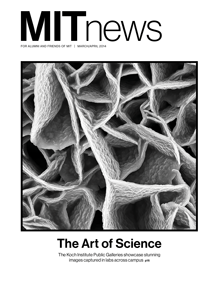Letters
Koch Institute Galleries Spark Curiosity
Everywhere you look in the medical field—from operating rooms to clinics in the developing world—engineering’s impact on patient health and well-being is enormous. As a chemical engineering graduate and current MD/PhD candidate, I have spent the past several years focusing on challenges at the interface of medicine, engineering, and biology. One example from oncology that has proved difficult to solve: How can we deliver medicines into tumors more effectively? For some therapies, only 1 to 2 percent of the administered dose may reach the targeted tumor. Selectively increasing therapeutic concentrations in tumors could improve the efficacy of existing therapies, reduce “off-target” toxicities, and significantly improve patient outcomes.

An image displayed in the Koch Institute Public Galleries (“The Art of Science,” March/April 2014) depicts one strategy that our lab has been studying. We locally heat tumor blood vessels to make them more permeable, allowing therapies circulating in the blood to enter the tumor more easily. To do this, we use biocompatible gold nanorods that build up within tumors and act like nanoscale antennas, converting externally delivered near-infrared light into heat. The image, acquired by a method called multiphoton microscopy, reveals long, tortuous blood vessels and gold nanorods residing within a living tumor environment. In biomedical research, we often develop our understanding of a process through inference, but being able to “look in” and directly visualize a complex process unfolding before our eyes can be very informative and provide new insights to explore in the future.
The benefits of these imaging technologies extend beyond the science itself. As a future physician, I hope that observing the living tumor’s environment at the microscopic level will help me communicate with patients about the nature of their illness and our treatment approaches.
By displaying the images for public viewing, the Koch Institute Public Galleries are also making an educational impact in the community. I can trace my interest in medicine and biomedical research to a public lecture at MIT that I attended in high school; it’s exciting to think that students visiting MIT today could walk past this collection of images, become curious, and start down their own paths toward careers in science, engineering, and medicine.
Alex Bagley ’08
Cambridge, Massachusetts
The Neurobiology of Habits
It is difficult to overstate the importance of habits as a structuring principle of human thought and behavior (“Why We Do What We Do,” January/February 2014). This insight was pioneered by William James, viewed by many as the father of American psychology. Ann Graybiel has taken up this tradition in her research by finding a neurobiological basis for habit performance. James believed that “all our life, so far as it has definite form, is but a mass of habits.” At the close of the 19th century, he could only describe in broad strokes the neurobiological underpinning of habit formation. Nearly 140 years later, and thanks to Graybiel’s groundbreaking research on the morphology and function of the basal ganglia, the neural circuitry of stimulus-response habits is known in considerable detail. Nonetheless, the influence of James can still be seen. He believed, for example, that in contrast to the simple stimulus-response associations that are typically studied in behavioral neuroscience, habits often consist of complex sequences of actions that coalesce into functional units—an intuition that Graybiel has systematized and made neurologically plausible in recent research. James also related habitual behaviors to higher cognitive functions, such as consciousness and volition, that are difficult to investigate with animal subjects. Our own habit research indicates that contrary to people’s self-perceptions, strong habits can be performed with relatively little input from motivations and volitional desires. Yet conscious intentions clearly exert an influence over habitual behaviors during habit formation and when people try to intentionally change unwanted habits. Understanding this interplay between habitual behaviors and conscious volition, and the neural basis for this interaction, is a challenge for future research.
Wendy Wood and Dennis Ruenger
Department of Psychology
University of Southern California
Celestial Tribute to President Vest
As the MIT community mourns the death of president emeritus Charles M. Vest, I wanted to let alumni know that a star was named for him in 2004 in honor of his distinguished 14-year presidency and his remarkable lifetime example. He was enormously pleased and flattered by that astronomical gesture.
“Charles M. Vest, 15th President, MIT” is up there in perpetuity near the North Star in the Northern Hemisphere. Its celestial coördinates are duly registered in the U.S. Patent and Trademark Office and in a diary kept in a Swiss bank.
Although property rights are not granted in the naming of heavenly bodies through the International Star Registry, it is very gratifying to have the MIT ethos planted in space through this permanent and affectionate tribute.
Vincent A. Fulmer, SM ’53
Arlington, Massachusetts
Keep Reading
Most Popular
Large language models can do jaw-dropping things. But nobody knows exactly why.
And that's a problem. Figuring it out is one of the biggest scientific puzzles of our time and a crucial step towards controlling more powerful future models.
How scientists traced a mysterious covid case back to six toilets
When wastewater surveillance turns into a hunt for a single infected individual, the ethics get tricky.
The problem with plug-in hybrids? Their drivers.
Plug-in hybrids are often sold as a transition to EVs, but new data from Europe shows we’re still underestimating the emissions they produce.
Stay connected
Get the latest updates from
MIT Technology Review
Discover special offers, top stories, upcoming events, and more.